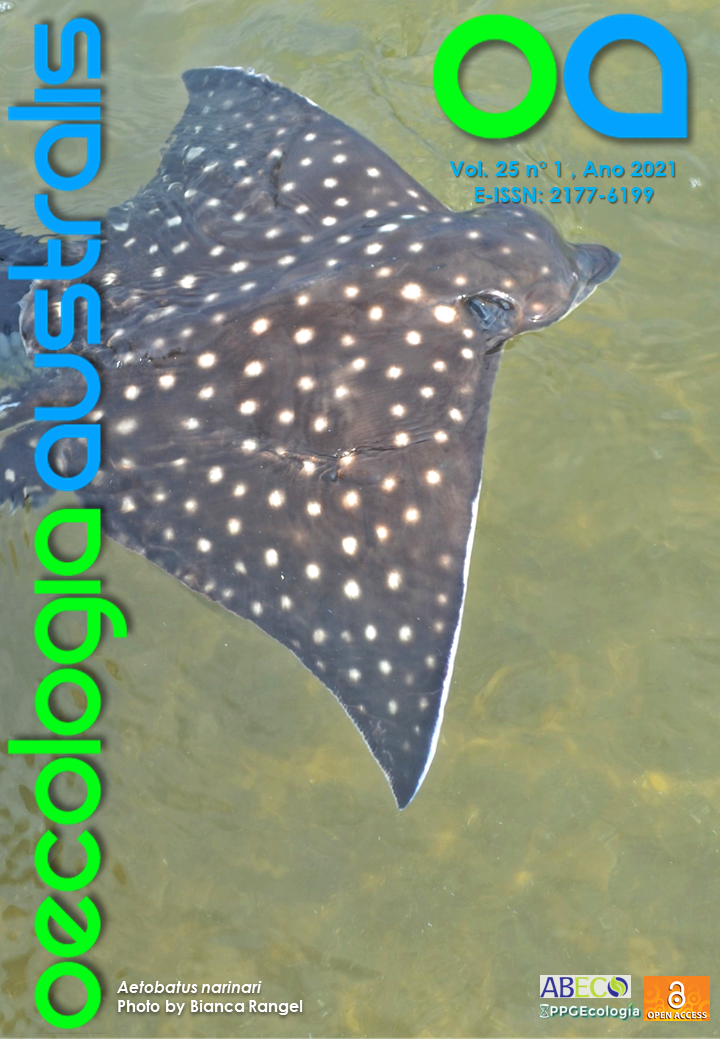COMPARAÇÃO DA EFICIÊNCIA DE FORRAGEIO DAS GARÇAS EGRETTA CAERULEA E EGRETTA THULA NO ESTUÁRIO DE PARANAGUÁ, PARANÁ, SUL DO BRASIL
DOI:
https://doi.org/10.4257/oeco.2021.2501.06Keywords:
birds, foraging, mangrove, PelecaniformesAbstract
A eficiência de forrageio das aves, resultado do balanço entre consumo e gasto de energia, pode variar conforme condições locais. A eficiência de forrageio foi comparada entre Egretta thula (adulto N = 11) e Egretta caerulea (adulto N = 62 e jovem N = 17) no estuário da cidade de Paranaguá, Paraná, Brasil. Em 14 h de observações divididas em sessões de 2 minutos por indivíduo, foram registrados locais de forrageio (lodo ou águas rasas), número de passos, bicadas totais e bicadas bem-sucedidas, e calculadas taxas de sucesso, esforço energético e eficiência de captura. Em águas rasas E. thula foi mais eficiente que E. caerulea. Não houve diferença para E. thula entre os ambientes, enquanto adultos de E. caerulea foram mais eficientes que os jovens, com maior eficiência no lodo do que em águas rasas. Diferenças na eficiência de forrageio entre as espécies podem ter relação com o tipo de forrageio entre elas dependendo da localidade.
COMPARISON OF EGRETTA CAERULEA AND EGRETTA THULA FORAGING EFFICIENCY IN ESTUARY OF OF PARANAGUÁ, PARANÁ, SOUTHERN BRAZIL: The foraging efficiency of birds may vary according to local conditions as a result of the balance between energy consumption and expenditure. The foraging efficiency of Egretta thula (adults n=11) and Egretta caerulea (adults n=69 and juveniles n= 17) was compared in Paranaguá city estuary, in Paraná, Brazil. In 14 hours of observation divided into 2 minutes sessions per individual, were recorded foraging site (mud or shallow water), number of steps, total peckings and successful peckings, and were calculated the success rates, energy effort and capture efficiency. In shallow water E.thula was more efficient than E. caerulea. There was no intraspecific differences in E. thula regarding environments. Adults of E. caerulea were more efficient than juveniles, with greater efficiency in mud than in shallow waters environments. Differences in foraging efficiency between species may be related to the type of foraging according to feeding location.
Downloads
References
Brzorad, J. N., Maccarone, A. D., & Conley, K. J. 2004. Foraging energetics of Great Egrets and Snowy Egrets. Journal of Field Ornithology, 75(3), 266–280. DOI: 10.1648/0273-8570-75.3.266
Choi, Y. S., & Yoo, J. C. 2011. Factors affecting feeding activity of grey herons in a reservoir during the breeding season. Journal of Ecology and Field Biology, 34(4), 357–363. DOI: 10.5141/JEFB.2011.037
Gawlik, D. E. 2002. The effects of prey availability on the numerical response of wading birds. Ecological Monographs, 72(3), 329–346. DOI: 10.1890/0012-9615(2002)072[0329:TEOPAO]2.0.CO;2
Gianuca, D., Gianuca, A. T., & Vooren, C. M. 2012. Abundance, breeding and food of the Little Blue Heron Egretta caerulea (Aves, Ardeidae) in the Patos Lagoon estuary, a recently colonized area in southern Brazil., 102(1), 19–25. DOI: 10.1590/S0073-47212012000100003
Gwiazda, R., Flis, A., Skórka, P., & Oles, W. 2017. Effect of age on the foraging behaviour of Grey Heron Ardea cinerea L., 1758 at a submontane dam reservoir in the post-breeding season. Avian Biology Research, 10(2), 76–83. DOI: 10.3184/175815617X14878495436442
Hamza, F., & Selmi, S. 2016. Co-occurrence and commensal feeding between Little Egrets Egretta garzetta and Eurasian Spoonbills Platalea leucorodia. Bird Study, 63(4), 509–515. DOI: 10.1080/00063657.2016.1238035
Harper, A. C., & Maccarone, A. D. 2018. Comparisons of foraging behavior and energetics by Great Egrets (Ardea alba) and Snowy Egrets (Egretta thula) across three microhabitats. Transactions of the Kansas Academy of Science, 121(1–2), 179–185. DOI: 10.1660/062.121.0222
Kelly, J. F., Gawlik, D. E., & Kieckbusch, D. K. 2003. An updated account of wading bird foraging behavior. The Wilson Bulletin, 115(1), 105–107. DOI: 10.1676/02-053
Lantz, S. M., Gawlik, D. E., & Cook, M. I. 2010. The effects of water depth and submerged aquatic vegetation on the selection of foraging habitat and foraging success of wading birds. The Condor, 112(3), 460–469. DOI: 10.1525/cond.2010.090167
MacArthur, R. H., & Pianka, E. R. 1966. On optimal use of a patchy environment. The American Naturalist, 100(916), 603–609. DOI: 10.1086/282454
Maccarone, A. D., & Brzorad, J. N. 2007. Foraging behavior and energetics of Great Egrets and Snowy Egrets at interior rivers and weirs. Journal of Field Ornithology, 78(4), 411–419. DOI: 10.1111/j.1557-9263.2007.00133.x
Maccarone, A. D., & Brzorad, J. N. 2005. Foraging microhabitat selection by wading birds in a tidal estuary, with implications for conservation. Waterbirds, 28(3), 383–391. DOI: 10.1675/1524-4695(2005)028[0383:fmsbwb]2.0.co;2
Martínez-Vilalta, A., Motis, A. & Kirwan, G.M. 2019. Snowy Egret (Egretta thula). In: del Hoyo, J., Elliott, A., Sargatal, J., Christie, D. A. & de Juana, E. (Eds.). Handbook of the Birds of the World Alive. Lynx Edicions, Barcelona. Retrieved from https://www.hbw.com/node/52693.
Nefla, A., & Nouira, S. 2016. Environmental factors affecting the foraging behavior of herons in Ichkeul National Park, Tunisia. Waterbirds, 39(1), 99–103. DOI: 10.1675/063.039.0112
Noernberg, M., Lautert, L., Araújo, A., Marone, E., Angelotti, R., Netto, J., & Krug, L. 2006. Remote sensing and GIS integration for modelling the Paranaguá estuarine complex -Brazil. Journal of Coastal Research,39(SI), 1627–1631.
R Core Team. 2015. R: A Language and Environment for Statistical Computing (Version 3.6.1). Vienna, Austria: R Foundation for Statistical Computing. Retrieved from http://www.r-project.org.
Recher, H. F., & Recher, J. A. 1969. Comparative foraging efficiency of adult and immature little blue herons (Florida caerulea). Animal Behaviour, 17(PART 2), 320–322. DOI: 10.1016/0003-3472(69)90017-7
Renken, R. C., Thompson, J. A., & Maccarone, A. D. 2016. Factors affecting foraging microhabitat selection by Wading Birds at an artificial weir. Waterbirds, 39(4), 422–425. DOI: 10.1675/063.039.0413
Rodgers, J. A. 1983. Foraging behavior of seven species of herons in Tampa Bay, Florida. Colonial Waterbirds, 6(1983), 11. DOI: 10.2307/1520962
Skórka, P., & Wójcik, J. D. 2008. Habitat utilisation, feeding tactics and age related feeding efficiency in the Caspian Gull Larus cachinnans. Journal of Ornithology, 149(1), 31–39. DOI: 10.1007/s10336-007-0208-3
Ydenberg R.C., Brown J.S. & Stephens, D.W. 2007. Foraging, an overview. In: Stephens, D., Brown, J. & Ydenberg, R. (Eds.). Foraging behavior and ecology. pp. 1–28. Chicago: University of Chicago Press.


